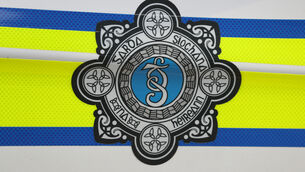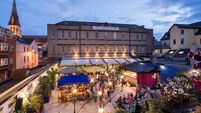Stardust's emergency exits in spotlight as witness questioned on ‘chasm’ in his account

Family and friends involved in the stardust fire inquests at the Coroners Court inquiry into the tragedy at The Rotunda Pillar Room on Parnell Square, Dublin, in May. A consensus has emerged on a number of points at the Stardust inquests. File photo: Gareth Chaney/ Collins Photos
Some witnesses at the Stardust inquests are in and out of court in 30 minutes. Some are there for days.
At this stage, the jury in the Pillar Room at Dublin’s Rotunda Hospital has heard from numerous staff members there on the night of the fire in February 1981. Barmen, waitresses, glass washers, doormen.
A consensus has emerged on a number of points. People began seeing a fire in a closed-off section of the north Dublin nightclub on or after 1.40am. It was on seats situated towards the back wall of the tiered seating area.
Some, but not all, of the people inside the venue were aware there was a fire. Witnesses have described seeing the fire and making efforts to begin leaving the Stardust while some people were still on the dancefloor. Nearly all remember the lights going off, and the panic that ensued.
There was no plan or training of what to do if such an event occurred, according to witness after witness at the inquests.
Some staff took it upon themselves to try fight the blaze. Those who did said the fire extinguishers had no effect on what was a rapidly spreading fire. Others attempted to raise the alarm and tell as many people as possible to get out of the Stardust.
And, the morning after the fire which would result in 48 deaths, staff convened in the Silver Swan and were told both not to speak to the press and to make a statement to Stardust manager Eamon Butterly’s solicitors, which came before their statements to gardaí.
These details building up a sense of what happened in those first few minutes will of course assist the jury in their deliberations. But the means of exit for many staff members may pale next to other evidence to come.
Barmen working at the main bar of the Stardust knew there was a back way from there into the Silver Swan pub that was part of the overall building complex. The waitresses knew there was a way from the kitchen to the Lantern Rooms bar and restaurant, and then out.
It’s the emergency exits that many patrons attempted to use that has come, and will continue to come, increasingly under the microscope at these inquests. That practice, it has heard, of draping chains around the emergency exit doors to give the appearance of being locked has been highlighted again and again.
It has heard of the difficulty in opening the doors when draped in such a way. And this was after the doors would be initially locked at the beginning of a disco night.
Junior staff members were only in their teens at the time, with no role in policymaking at the Stardust. Their knowledge and awareness of the locking of doors and of draping the chains has been tested by the various barristers representing interested parties at the inquests.
But during what would be a lengthy series of questions posed by Michael O’Higgins SC to one witness this week, the vastly experienced barrister who represents some of the families of victims explained his approach.
He was clear that an inquest “cannot exonerate anybody” and “cannot blame anybody”.
“That doesn’t mean in asking the questions, we’re not entitled to ask why something was done or not done,” Mr O’Higgins told John Furley, a then 23-year-old, part-time doorman at the Stardust.
He said earlier witnesses were “low on the food chain” in terms of seniority at the venue, but that Mr Furley was “not at the bottom of the food chain but neither at the top”, having previously been the head waiter.
The policy around making doors appear as if locked was said to have arisen over issues around patrons letting friends in without paying. Mr Furley said that he did not know if Mr Butterly was “very vexed” by people getting in for free, but said Mr Butterly “didn’t like to be bested”.
A crucial point here is that Mr Furley got out through one of the emergency exits, dubbed exit 5. Mr O’Higgins put it to him that there’s a “chasm” between his account of getting out of this exit and the accounts given by others.
This exit was partially blocked by a skip used for empty bottles. Multiple witnesses have described many having difficulty in getting these doors open as the fire began was spreading. Some witnesses also described a doorman kicking at the door and a padlock on the door in a bid to get it open.
He said that witnesses were “wrong” in their statements identifying him as that man, and said he was pushing down the bar on the door when they opened.
“There were guys kicking the door,” he said.
Mr O’Higgins put it to Mr Furley that in his original statements back in 1981 he was letting those who ran the Stardust “off the hook” for padlocks and chains on the doors by “blaming the patrons for not being able to get out”.
Mr Furley replied that that wasn’t true. After a brief break, he did not return to court and his evidence is expected to continue at a later stage.
This focus on the exits and everything to do with them will not stop at the close of Mr Furley’s evidence. To use Mr O’Higgins’ words, there are witnesses “higher up the food chain” that will be heard from as the inquests continue at Dublin District Coroner’s Court.












